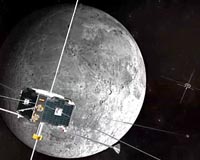 |
Moffett Field CA (SPX) Nov 19, 2010 NASA is preparing to fly a small satellite about the size of a loaf of bread that could help answer astrobiologys fundamental questions about the origin, evolution, and distribution of life in the universe. The nanosatellite, known as Organism/Organic Exposure to Orbital Stresses, or O/OREOS, is a secondary payload aboard a U.S. Air Force four-stage Minotaur IV rocket planned for launch on Nov. 19, 2010. O/OREOS weighs approximately 12 pounds and is NASAs first CubeSat to demonstrate the capability to have two distinct, completely independent science experiments on a single autonomous satellite. O/OREOS also will use NASAs first propellant-less mechanism on a scientific satellite to ensure it de-orbits and burns up as it re-enters Earths atmosphere less than 25 years after completing its mission. "Secondary payload nanosatellites, like O/OREOS are an innovative way to extend and enhance scientists' opportunities to conduct research in low Earth orbit by providing an alternative to the International Space Station or space shuttle investigations," said Pascale Ehrenfreund, O/OREOS project scientist at the Space Policy Institute at George Washington University. "With O/OREOS we can analyze the stability of organics in the local space environment in real-time and test flight hardware that can be used for future payloads to address fundamental astrobiology objectives." The Minotaur IV rocket is on the launch pad at the Alaska Aerospace Corporations Kodiak Launch Complex on Kodiak Island, Alaska and the range is conducting final launch preparations. The U.S. Air Force has announced that the rocket could launch at any time during a 90-minute launch window beginning at 5:24 p.m. PST on Nov. 19, 2010. After O/OREOS separates from the Minotaur IV rocket and successfully enters low Earth orbit at approximately 400 miles above Earth, it will activate and begin transmitting radio signals to ground control stations and spacecraft operators in the mission control center at Santa Clara University, Santa Clara, Calif. "We are excited to have this opportunity to demonstrate the utility of these very small spacecraft in space for NASA's science missions," said Bruce Yost, O/OREOS mission manager at NASA's Ames Research Center, Moffett Field, Calif. "Were hoping to demonstrate NASAs ability to build complex nanosatellites like O/OREOS that can meet the needs of scientists with big ideas and lofty goals." Spacecraft operators could make contact with O/OREOS as soon as 12.5 hours after launch. O/OREOS will conduct experiments, which will last up to six months, autonomously or after receiving a command from the Santa Clara ground station. Once the experiments begin, O/OREOS will relay data daily to mission managers, engineers and project scientists for further analysis. Spacecraft operators say the nanosatellite is scheduled to transmit mission data for a year. O/OREOS, the first technology demonstration mission of NASA's Astrobiology Small Payloads Program, contains two experiment payloads, including the Space Environment Survivability of Live Organisms (SESLO), which will characterize the growth, activity, health and ability of microorganisms to adapt to the stresses of the space environment, and the Space Environment Viability of Organics (SEVO), which will monitor the stability and changes in four classes of organic molecules as they are exposed to space conditions. The SESLO payload will monitor biological organisms' responses as they are exposed to radiation and weightless conditions in space. The experiment is sealed and contains two types of microbes commonly found in salt ponds and soil in a dried and dormant state: Halorubrum chaoviatoris and Bacillus subtilis. After O/OREOS reaches orbit, the experiment will rehydrate, or "feed," and grow three sets of microbes. The SESLO experiment measures the microbes population density and change in color while they consume the dyed liquid nutrients. For the SEVO experiment, scientists selected molecules distributed throughout our galaxy, as well building blocks of life. O/OREOS houses the organic samples in "micro environments" to mimic space and planetary conditions. The experiment will expose the organic compounds to radiation in the form of solar ultraviolet (UV) light, visible light, trapped-particle and cosmic radiation. Scientists will determine the stability of the molecules by studying the changes in UV, visible and near-infrared light absorption. The Small Spacecraft Division at NASA's Ames Research Center, Moffett Field, Calif., manages the O/OREOS payload and mission operations supported by staff and students from Santa Clara University, Santa Clara, Calif. As with NASA's previous small satellite missions, such as the GeneSat-1 and PharmaSat, Santa Clara University invites amateur radio operators around the world to tune in to the satellite's broadcast.
Share This Article With Planet Earth
Related Links O/OREOS Microsat News and Nanosat News at SpaceMart.com
 Berkley Microsats Take Lunar Excursion For Extended Time
Berkley Microsats Take Lunar Excursion For Extended TimeBerkeley CA (SPX) Oct 28, 2010 Two micro-satellites originally launched into Earth's orbit in 2007 by NASA have been redirected by University of California, Berkeley, scientists toward new orbits around the moon, extending study of the earth and moon's interactions with the solar wind. The second of the two probes settled into a temporary "Lagrange-point" orbit on Friday, Oct. 22, inaugurating science operations for a n ... read more |
|
| The content herein, unless otherwise known to be public domain, are Copyright 1995-2010 - SpaceDaily. AFP and UPI Wire Stories are copyright Agence France-Presse and United Press International. ESA Portal Reports are copyright European Space Agency. All NASA sourced material is public domain. Additional copyrights may apply in whole or part to other bona fide parties. Advertising does not imply endorsement,agreement or approval of any opinions, statements or information provided by SpaceDaily on any Web page published or hosted by SpaceDaily. Privacy Statement |